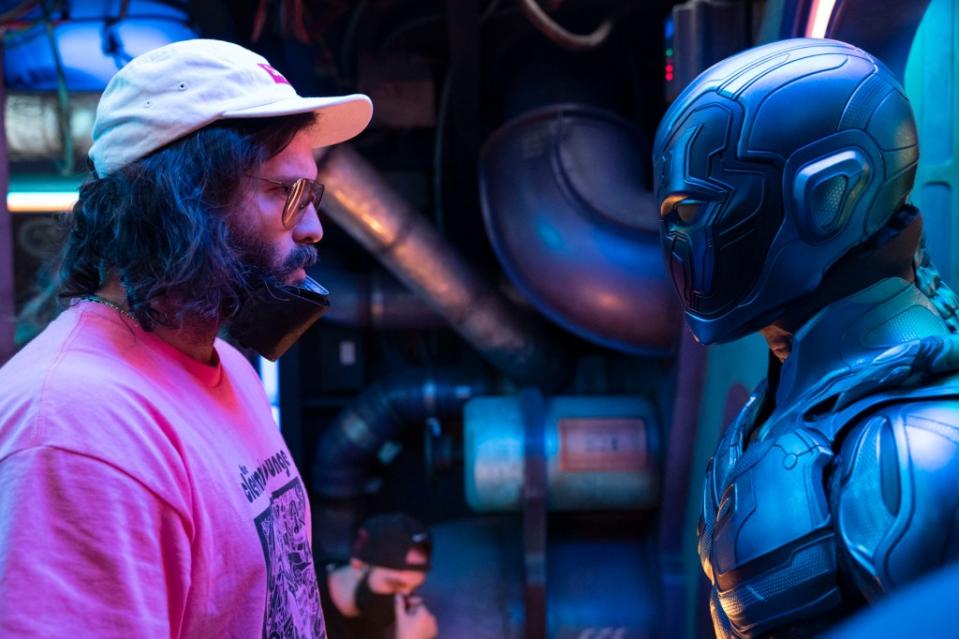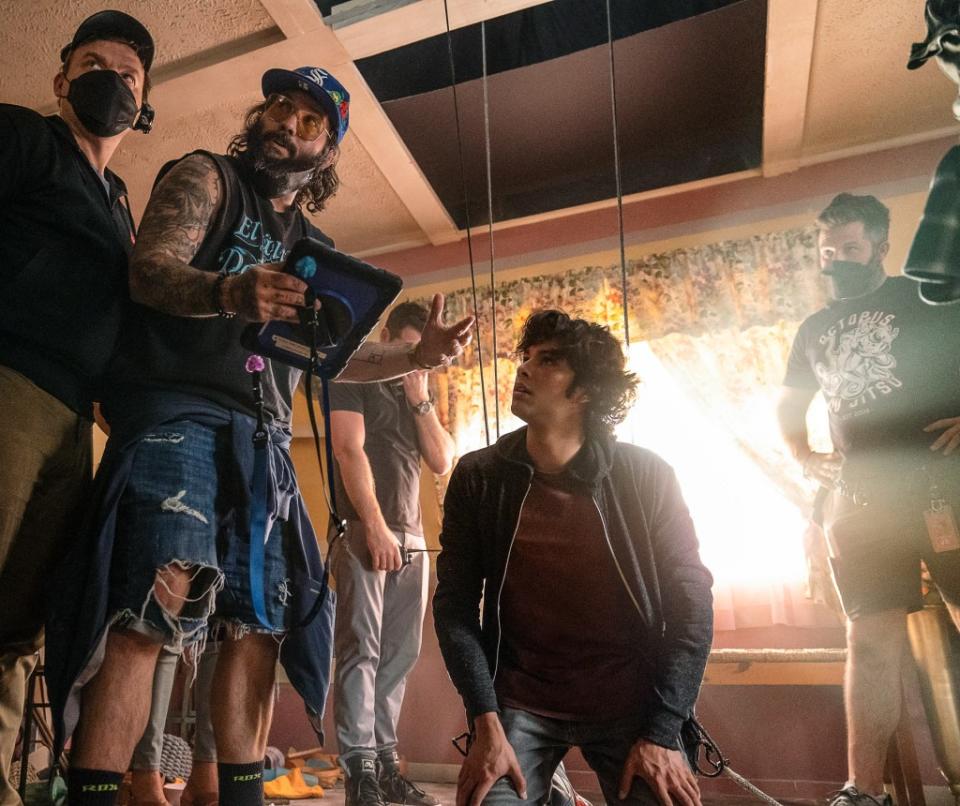‘Blue Beetle’ Director Ángel Manuel Soto Talks Latino Resilience and Creating ‘Cronenberg for Kids’
- Oops!Something went wrong.Please try again later.
- Oops!Something went wrong.Please try again later.

“Blue Beetle” director Ángel Manuel Soto is an eternal optimist.
It was January 2020 when Soto’s coming-of-age story “Charm City Kings” debuted at the Sundance Film Festival, winning the U.S. Dramatic Special Jury Prize for ensemble acting. Sony Pictures Classics planned to release the film on April 10, which would have come after its intended bow at South by Southwest on March 15. Yet, as for so many movies, a global pandemic changed those plans. It eventually ended up in the hands of HBO Max ahead of its rebrand, but if anyone visits Max, it’s not available, as it was one of the movies that was quietly removed from the platform.
More from Variety
DC Studios Appoints Candice McDonough as Publicity and Communications Chief
Superhero Fatigue Is Real. The Cure? Make Better Movies Than 'The Flash'
And here Soto is again, sitting in a hotel room on Zoom amid his travels without his actors and writers to promote the film, which opens Aug. 18. He’s going at it alone due to the ongoing Hollywood strikes, hoping to get moviegoers to come out and see his latest vision. “I think it’s just the way it goes with me,” he says. “If anything, let it be a testament to my resilience. It’s part of my Puerto Rican DNA.”

In addition to being the first film under the guidance of new DC Studios heads James Gunn and Peter Safran, “Blue Beetle” marks the first Latino superhero character for Warner Bros. Amid the difficult climate in Hollywood, Soto might be echoing a line spoken by his lead character Jaime Reyes (played charismatically by Xolo Maridueña) in a scene in “Blue Beetle” where he yells in despair: “This shit doesn’t get better for us!”
Soto can see the obstacles stacked against him, but he’s determined to emerge victorious. “I think about it constantly and how this could have been our moment,” he tells Variety. “But no, it’s not could. It’s still our moment.”
“Blue Beetle” follows Jaime Reyes as he returns to his hometown after college graduation, where his family struggles to make ends meet. Soon after, he is chosen to become a symbiotic host to the Scarab, an ancient alien biotechnological relic that grants him a powerful exoskeleton armor, turning him into the titular superhero. The film also stars Latino talent like Oscar nominee Adriana Barraza (“Babel”), George Lopez, Damián Alcázar, Bruna Marquezine, Belissa Escobedo and Raoul Max Trujillo, along with Susan Sarandon.
Soto, 40, didn’t attend film school like many of his colleagues in the industry. A native of Santurce, Puerto Rico, one of the most densely populated areas on the island, he attended university on a soccer scholarship studying architecture. Despite being a die-hard cinephile and wanting to make movies, film school had too high a pricetag. Instead, he shelved his passion for later in life. “I had to spend a lot of money to create a network where I would learn by doing, not by going to school,” he says.
That natural talent is what executives like Peter Safran, co-chairperson, and CEO of DC Studios, saw in Soto’s “Charm City Kings,” which convinced him Soto was the right person for the job. “It was a coming-of-age story that had similar elements that were translatable to ‘Blue Beetle’ on a larger scale,” Safran says. “When you look at some of the great superhero movies, they’ve come from filmmakers not known for that particular genre.” Safran points to blockbuster and critical hits such as “Iron Man” from Jon Favreau, “Shazam,” directed by David Sandberg, or his co-CEO Gunn with “Guardians of the Galaxy.”
Soto began his career in entertainment as a TV producer, later focusing on art direction at an advertising agency. He made his directorial debut with “La Granja,” a film looking at the harsh realities of his native island, something Soto knows too well. Soto’s father was a lifelong Teamster and union advocate and one of the many protestors to remove Ricardo A. Rosselló, the corrupt Puerto Rico governor, in 2019.
You see Soto’s cinematic inspirations in every frame, referencing classic tentpole franchises like “Mission: Impossible” and “Indiana Jones.” He utilizes this nostalgic energy to portray the first superhero that does not want his superpowers. In fact, Soto knew what he wanted for Jaime’s transformation into the blue exoskeleton. “How can we do [David] Cronenberg for kids?” he says. “I wanted the energy to be fun but also tell the story about the movies that made me love movies.”

Incorporating humor and action-packed battle sequences, “Blue Beetle” tells an origin story that shows promise for future iterations.
The filmmaker saw too much of himself in Jaime to not tell this story. One aspect that was important to him was the accurate pronunciation of their names, which is often disregarded in American culture — Jaime (pronounced “hay-meh”) and Ángel (“ahng-hehl”). In addition, a scene with Sarandon’s villainous Victoria Kord calling her employee scientist Sanchez (Harvey Guillén), despite it not being his name. The goal is to show that Latinos are not a monolith, and as underrepresented and misunderstood as we are in Hollywood, we are powerful when united. That’s why he’s meticulous when presenting Jaime’s family, whom he wants the audience to love and see themselves represented in, Latino or not. “By the end of the first act, you know this family. You feel the warmth. You can almost smell the food,” he says.
For decades, Latino artists have faced numerous barriers in Hollywood, including typecasting and limited opportunities. The lack of diversity behind the scenes has often resulted in a skewed representation of Latino characters, perpetuating stereotypes rather than reflecting the rich complexity of their culture and experiences.
Furthermore, securing financing for Latino-led projects can be particularly challenging due to the perception of limited market appeal. It’s a curious perception since Latinos comprise 20% of the U.S. population and represent more than 25% of domestic box office ticket sales.
The disparity in data tells the story. In a 2021 study by USC Annenberg that looked at over 1,300 films over a 13-year timeframe, only 5% of 51,158 characters identified were Hispanic or Latino. Furthermore, only 4.2% of the movies had Latino or Hispanic directors attached; even worse, only three Latina women were among them all.
While there have been Latino characters in the DC universe previously – Jay Hernandez as El Diablo in “Suicide Squad,” and Rosie Perez as Renee Montoya in “Birds of Prey” – the pressure for the film’s success couldn’t be any more pronounced after seeing the cancellation of “Batgirl” with Leslie Grace, and the underwhelming reception of “The Flash” which featured Sasha Calle as Supergirl. The fear beginning to seep into Latino communities is that if “Blue Beetle” is deemed a “failure,” it will only worsen Latinos’ visibility, preventing more projects like these for decades.
“It’s up to people like us to ensure that doesn’t happen,” says Safran. “Whether it’s Pam [Abdy] and Mike [DeLuca] or us in DC, it’s in our hands to make sure that we show a diverse slate of movies with different kinds of people represented on screen. I believe the audience will turn up for ‘Blue Beetle.’ It’s a success story that people will want to replicate.”
Filmmakers are also voicing their support for the upcoming superhero flick such as “Justice League” director Zack Snyder, who shared his excitement with his 1.4 million Twitter followers, which will surely help increase public awareness. “Looking forward to taking my kids to see Blue Beetle. #RepresentationMatters.”
With a screenplay by Mexican writer Gareth Dunnet-Alcocer (“Miss Bala”), the film is anchored with messages that can connect all viewers. Dunnet-Alcocer and Soto turn the idea that “Latinos are invisible” on its head with the line, “Invisibility is our superpower.”
“They tell us about this ‘glass ceiling’ and then tell us we should feel complacent and be grateful that we’ve even reached that ceiling. Every time someone like us excels, it’s a big surprise. We always knew we could do that. I believe in the power of community, and I’m not a fatalist. I’m a relentless optimist,” says Soto.
It’s hard to recall a mainstream movie in which so many crew members and actors’ names with accent marks and tildes on their names can be seen when the credits roll, showing the vast diversity of artists behind the camera.
Plenty of Easter Eggs are sprinkled in “Blue Beetle,” pointing to the connection with other DC titles.
There are scenes with a “Gotham Law” jacket and where George Lopez’s Uncle Rudy hilariously calls Batman “a fascist.” We even see some open boxes of Oreos, the favorite snack of the Martian Manhunter, a core member of the Justice League. With Warner Bros. reportedly discussing some shuffling of its 2023 projects including “The Color Purple,” “Dune: Part Two” and another DC Studios sequel “Aquaman and The Lost Kingdom,” Warner Bros. insiders tell Variety the Jason Momoa film is expected to hold its Dec. 20 release date.
Soto realizes that despite the promotional hurdle the strikes have imposed, the guilds are striking to help the people that make up his team.
“We want the movie to succeed, but I also want my actors and writers to be treated as they should. If that happens, we’ll have more stories like this. Things that are often deemed impossible are not.”
Best of Variety
'House of the Dragon': Every Character and What You Need to Know About the 'Game of Thrones' Prequel
25 Groundbreaking Female Directors: From Alice Guy to Chloé Zhao
Sign up for Variety’s Newsletter. For the latest news, follow us on Facebook, Twitter, and Instagram.

